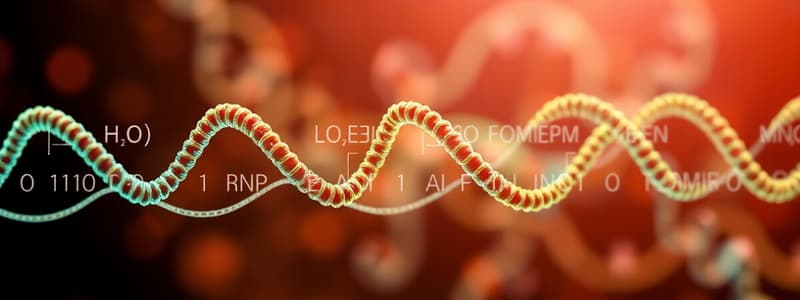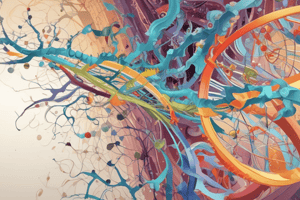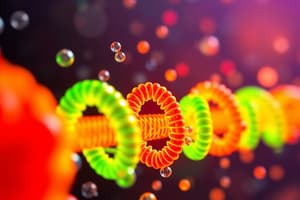Podcast
Questions and Answers
What is the primary purpose of amino acid composition analysis in protein sequencing?
What is the primary purpose of amino acid composition analysis in protein sequencing?
- To cleave the protein into smaller peptides.
- To identify the amino acids present and their proportions. (correct)
- To determine the protein's tertiary structure.
- To identify the N-terminal amino acid.
Hydrolyzing a protein in 6M hydrochloric acid at high temperatures breaks peptide bonds.
Hydrolyzing a protein in 6M hydrochloric acid at high temperatures breaks peptide bonds.
True (A)
Which of the following provides quantitative data about amino acids in a protein sample?
Which of the following provides quantitative data about amino acids in a protein sample?
- Edman degradation
- Amino acid analyzer (correct)
- High-performance liquid chromatography (HPLC)
- Ion-exchange chromatography
The Edman degradation method uses ______ to modify the N-terminal amino acid.
The Edman degradation method uses ______ to modify the N-terminal amino acid.
What is the purpose of using multiple cleavage methods in protein sequencing?
What is the purpose of using multiple cleavage methods in protein sequencing?
Cyanogen bromide cleaves peptide bonds at all amino acid residues.
Cyanogen bromide cleaves peptide bonds at all amino acid residues.
What type of data does ion-exchange chromatography provide in amino acid analysis?
What type of data does ion-exchange chromatography provide in amino acid analysis?
Which enzyme cleaves peptide bonds at the carboxyl side of aromatic amino acids?
Which enzyme cleaves peptide bonds at the carboxyl side of aromatic amino acids?
Enzymes called ______ selectively cleave one amino acid at a time from the C-terminus of a protein.
Enzymes called ______ selectively cleave one amino acid at a time from the C-terminus of a protein.
DNA sequencing can directly detect post-translational modifications.
DNA sequencing can directly detect post-translational modifications.
Which reagent is used in Edman degradation to release the modified N-terminal amino acid?
Which reagent is used in Edman degradation to release the modified N-terminal amino acid?
What characteristic of peptides produced by trypsin cleavage makes them easily identifiable?
What characteristic of peptides produced by trypsin cleavage makes them easily identifiable?
Which amino acid residue does cyanogen bromide cleave specifically?
Which amino acid residue does cyanogen bromide cleave specifically?
The Edman degradation process is limited to sequencing approximately ______ amino acids due to accumulating errors.
The Edman degradation process is limited to sequencing approximately ______ amino acids due to accumulating errors.
Determining the N-terminal and C-terminal amino acids is crucial for verifying whether a protein consists of a single or multiple polypeptide chains.
Determining the N-terminal and C-terminal amino acids is crucial for verifying whether a protein consists of a single or multiple polypeptide chains.
What is a disadvantage of using DNA sequencing instead of Edman degradation for protein sequencing?
What is a disadvantage of using DNA sequencing instead of Edman degradation for protein sequencing?
What type of chromatography technique is used to separate and identify individual amino acids after protein hydrolysis?
What type of chromatography technique is used to separate and identify individual amino acids after protein hydrolysis?
In Edman degradation, what chemical reaction occurs after phenylisothiocyanate combines with the N-terminus of a peptide under mildly alkaline conditions?
In Edman degradation, what chemical reaction occurs after phenylisothiocyanate combines with the N-terminus of a peptide under mildly alkaline conditions?
In the context of protein cleavage, if trypsin digestion results in a peptide fragment 'Ser-Glu-Asn-Leu-Ile-Arg', the amino acid residue at the C-terminal end of this fragment is ______.
In the context of protein cleavage, if trypsin digestion results in a peptide fragment 'Ser-Glu-Asn-Leu-Ile-Arg', the amino acid residue at the C-terminal end of this fragment is ______.
Consider a polypeptide 'Val-Met-Ala-Gly' that undergoes cleavage with cyanogen bromide. What are the resulting fragments?
Consider a polypeptide 'Val-Met-Ala-Gly' that undergoes cleavage with cyanogen bromide. What are the resulting fragments?
Flashcards
Protein Hydrolysis
Protein Hydrolysis
Breaks down a protein into its constituent amino acids using heat and strong acid (6M HCl).
Qualitative Amino Acid Data
Qualitative Amino Acid Data
Identifies the types of amino acids present in a protein.
Quantitative Amino Acid Data
Quantitative Amino Acid Data
Determines the quantity of each amino acid present in a protein.
Edman Degradation
Edman Degradation
Signup and view all the flashcards
Carboxypeptidases
Carboxypeptidases
Signup and view all the flashcards
Trypsin
Trypsin
Signup and view all the flashcards
Chymotrypsin
Chymotrypsin
Signup and view all the flashcards
Cyanogen Bromide (CNBr)
Cyanogen Bromide (CNBr)
Signup and view all the flashcards
Trypsin Cleavage
Trypsin Cleavage
Signup and view all the flashcards
Chymotrypsin Cleavage
Chymotrypsin Cleavage
Signup and view all the flashcards
Cyanogen Bromide Cleavage
Cyanogen Bromide Cleavage
Signup and view all the flashcards
Edman Degradation
Edman Degradation
Signup and view all the flashcards
DNA Sequencing for Protein Analysis
DNA Sequencing for Protein Analysis
Signup and view all the flashcards
Amino Acid Composition Analysis
Amino Acid Composition Analysis
Signup and view all the flashcards
N- and C-Terminal Identification
N- and C-Terminal Identification
Signup and view all the flashcards
Cleavage into Peptides
Cleavage into Peptides
Signup and view all the flashcards
Sequencing Peptides
Sequencing Peptides
Signup and view all the flashcards
Alternative Method: DNA Sequencing
Alternative Method: DNA Sequencing
Signup and view all the flashcards
Protein Fragmentation
Protein Fragmentation
Signup and view all the flashcards
Study Notes
Determining Primary Structure of a Protein
- Determining the primary structure of a protein involves several key steps to identify the amino acids present and their sequence.
Amino Acid Composition Analysis
- Before sequencing, determine which amino acids are present and their proportions.
- Hydrolyze the protein into individual amino acids using heat in 6M hydrochloric acid (HCl) at 100–110°C for 12–36 hours, which breaks all peptide bonds.
- Separate and identify the resulting amino acid mixture using ion-exchange chromatography or high-performance liquid chromatography (HPLC).
- An amino acid analyzer provides qualitative data (which amino acids are present) and quantitative data (how much of each amino acid is present).
- This step guides sequencing by identifying rare or modified amino acids like hydroxyproline.
Identification of N-terminal and C-terminal Amino Acids
- Determines where the protein sequence starts and ends.
- Verifies whether the protein consists of one or multiple polypeptide chains.
N-terminal Identification
- Edman degradation uses phenyl isothiocyanate (PITC), which binds to the first amino acid and releases it as a stable phenylthiohydantoin (PTH) derivative detectable chromatographically.
C-terminal Identification
- Carboxypeptidases are enzymes that selectively cleave one amino acid at a time from the C-terminus.
- This step is less common now, modern sequencing techniques can directly determine the full sequence without needing separate N- and C-terminal analysis.
Cleavage of Protein into Peptides
- Long polypeptide chains (100+ residues) are broken into smaller fragments (20–50 amino acids each) for easier sequencing.
Enzymatic Cleavage
- Specific proteolytic enzymes (proteases) cleave peptide bonds at defined sites.
Trypsin Specifics
- Trypsin cleaves at the carboxyl side of basic amino acids like Lysine (Lys, K) and Arginine (Arg, R).
- For example, Ala—Arg—Gly—Lys—Phe is cleaved into Ala—Arg, Gly—Lys, and Phe.
- Results in peptides with positively charged residues (Lys, Arg) at the C-terminal end.
- It is a proteolytic enzyme that cleaves only peptide bonds where arginine or lysine contributes the carbonyl function.
Chymotrypsin Specifics
- Cleaves at the carboxyl side of aromatic amino acids like Tyrosine (Tyr, Y), Tryptophan (Trp, W), and Phenylalanine (Phe, F).
- For example, Ser—Tyr—Gly—Trp—Leu—Phe is cleaved into Ser—Tyr, Gly—Trp, and Leu—Phe.
- Chymotrypsin hydrolyzes proteins at aromatic amino acids.
Reason for Multiple Cleavage Methods
- Different methods generate overlapping peptide fragments, allowing reconstruction of the full sequence.
- Trypsin cleaves at Arg and Lys, producing certain peptides, while chymotrypsin cleaves at Tyr, Trp, and Phe, producing different peptides.
- Overlapping fragments from both methods help piece together the original protein sequence.
- Once peptides are obtained, they are separated and purified using chromatography techniques like HPLC.
Chemical Cleavage
- Some chemical reagents can break peptide bonds at specific amino acid residues.
Cyanogen Bromide (CNBr)
- Cleaves at methionine (Met, M) residues.
- Produces peptides where C-terminal ends are homoserine lactone.
- For example: Val-Met-Ala-Gly is cleaved into Val-Met and Ala-Gly.
Determining the Amino Acid Sequence
- The most common method for sequencing peptides (10–40 residues long) is Edman Degradation.
- Phenyl isothiocyanate (PITC) is used to modify the N-terminal amino acid, which is then selectively cleaved and identified.
Steps of Edman Degradation
- PITC binds to the N-terminal amino acid.
- The modified residue is cleaved off without breaking the rest of the peptide.
- The released amino acid is detected using HPLC.
- The process is repeated for the next amino acid to determine the sequence step-by-step.
Limitations of Edman Degradation
- It can only sequence up to ~40 amino acids before errors accumulate.
- It is ineffective if the N-terminus is blocked by chemical modifications.
Mechanism of Peptide Sequencing by Edman Degradation
- Phenylisothiocyanate interacts with the N-terminus of a peptide under mildly alkaline conditions, resulting in a phenylthiocarbamoyl substitution.
- Treatment with trifluoroacetic acid (TFA) causes cyclization, leading to the release of the N-terminal amino acid residue as a thiazolinone derivative, leaving other peptide bonds intact.
- The N-terminal amino acid is then obtained as a phenylthiohydantoin (PTH) derivative through organic extraction and processing with aqueous acid.
- This sequence of steps is reiterated to reveal the N-terminus at subsequent phases until the full composition of the peptide is ascertained.
DNA Sequencing as an Alternative Method
- Instead of sequencing the protein directly, the gene encoding the protein can be sequenced using modern DNA sequencing techniques.
Advantages of DNA Sequencing
- Faster and more efficient than protein sequencing.
- Can predict the entire protein sequence using the genetic code.
Limitations of DNA Sequencing
- Post-translational modifications (PTMs) are not detected like disulfide bonds, phosphorylation, and glycosylation.
- Alternative splicing may create different protein variants not reflected in the gene sequence.
Studying That Suits You
Use AI to generate personalized quizzes and flashcards to suit your learning preferences.




